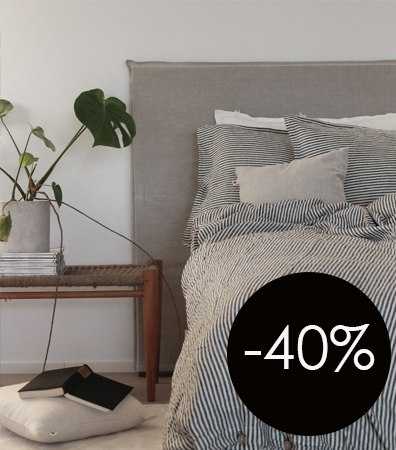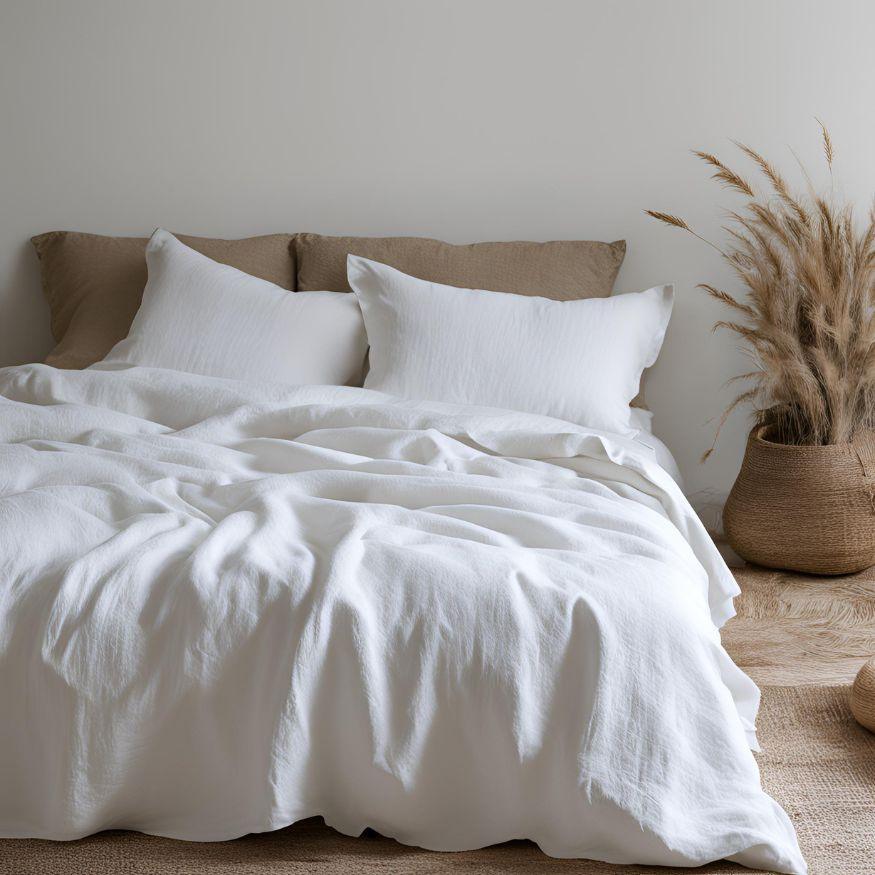Australia Linen vs Cotton: Which Is Better for Summer Wear?
Australia Linen vs Cotton: Which Is Better for Summer Wear?
Blog Article
Understanding Bed Linen: The Eco-Friendly Option for Comfortable Living
When you consider green materials, bed linen frequently stands apart for its one-of-a-kind top qualities. This natural fabric, made from the flax plant, offers both convenience and sustainability. Its exceptional residential properties make it an optimal selection for warm weather condition and long-lasting use. Yet what really establishes bed linen aside from various other products? Comprehending its origins and advantages can transform just how you view home textiles. Let's check out the remarkable globe of linen even more.
The Origins of Bed Linen: From Flax to Textile

Bed linen, one of the oldest textiles recognized to mankind, has a remarkable trip that begins with the humble flax plant. As soon as collected, the flax stalks go through a process called retting, where they're soaked to divide the fibers from the woody parts.
When you see linen fabric, you're observing centuries of workmanship. The weaving process transforms those spindles of thread into the beautiful, durable towel you love. Linen has actually been treasured for its natural look, making it a favored for whatever from apparel to home fabrics. Next time you touch bed linen, remember its abundant history that connects you to old societies and their traditional practices.
The Unique Residence of Bed Linen
Among the standout attributes of this impressive textile is its breathability. When you put on linen, you'll notice just how it allows air to flow, maintaining you cool down on warm days. This residential or commercial property makes it an ideal selection for summertime clothes and bed linens.
Linen also boasts extraordinary moisture-wicking capacities, drawing sweat far from your skin and allowing it to evaporate swiftly. You won't feel clammy, even in humid problems. In addition, bed linen is long lasting, often becoming softer and much more comfy with each wash, which means it can stand the examination of time in your closet.
Another distinct aspect is its all-natural structure; the slight abnormalities offer linen a character that improves your style. And also, it withstands creases far better than lots of other textiles, so you can delight in a relaxed yet brightened appearance without much initiative. Embrace bed linen, and you'll appreciate its comfort and distinct beauty.
Environmental Advantages of Linen
When you pick linen, you're not simply deciding for a gorgeous textile; you're additionally sustaining sustainable manufacturing techniques. Linen's naturally degradable and compostable nature makes it a smart selection for the atmosphere. And also, it requires substantially much less water to create contrasted to other textiles, helping preserve this priceless source.
Lasting Manufacturing Practices
Although numerous materials have significant ecological influences, bed linen stands out due to its sustainable production practices. When you pick linen, you're deciding for a textile made from the flax plant, which requires minimal water and pesticides.
Bed linen production is frequently less energy-intensive compared to various other textiles, as it entails natural processes rather than synthetic treatments. By sustaining bed linen, you're adding to a much more sustainable textile sector that prioritizes environment-friendly techniques. Choosing bed linen not only enhances your comfort but additionally straightens your values with ecological obligation.
Compostable and biodegradable Material
Linen's green nature expands past its lasting manufacturing; it's additionally eco-friendly and compostable, making it an exceptional option for ecologically conscious customers. When you pick linen products, you're deciding for products that break down normally, returning nutrients to the planet. Composting linen can improve dirt, promoting healthy and balanced plant development.
Low Water Consumption
One of the standout advantages of linen is its low water intake during growing. Unlike cotton, which requires considerable watering, bed linen's flax plant flourishes on marginal water, making it a more sustainable option. You'll value knowing that for every heap of bed linen produced, significantly much less water is required compared to numerous various other fabrics.
Bed linen vs. Other Fabrics: A Comparison
When you compare bed linen to various other materials, you'll see its exceptional breathability and comfort, making it best for cozy climate. Plus, linen stands apart for its durability and long life, commonly lasting longer than many typically utilized materials. As you consider your selections, the ecological impact of each fabric will also play a vital function in your decision.
Breathability and Comfort
Breathability is an essential consider selecting materials for comfort, especially in warm weather. Linen stands out amongst products for its exceptional capability to enable air flow. Unlike synthetic fabrics, which can catch warmth and wetness, linen's natural fibers wick away sweat, maintaining you completely dry and amazing. When you use linen, you'll notice just how it feels light against your skin, improving your convenience during warm days.
Cotton is typically applauded for its softness, however it doesn't match linen's breathability. Even blends may not supply the very same air flow. If you focus on comfort, especially in summertime, bed linen must be your best choice. It not only keeps you really feeling fresh but likewise brings an ageless style to your closet.
Toughness and Durability
While lots of materials use varying degrees of resilience, bed linen really masters long life, making it a wise financial investment for your wardrobe. Unlike cotton or artificial materials that might break swiftly, linen gets stronger with each clean. Its natural fibers withstand fading and fraying, ensuring your garments look fantastic with time. You'll locate that linen's breathable nature likewise lowers wear from sweat and wetness, which can harm other materials. And also, its capacity to withstand high temperature levels indicates it will not diminish conveniently in the dryer. When you choose linen, you're going with a resilient fabric that can take care of everyday use while keeping its charm. Depend on me, your long-term financial investment in linen will settle with years of elegant, comfortable wear.
Environmental Impact Comparison
Although many textiles add to ecological problems, linen stands out for its environmentally friendly qualities. Unlike cotton, which requires massive water sources and chemicals, linen is made from flax, a plant that thrives on marginal water and requires fewer chemicals. This suggests you can really feel good about your selection while minimizing your carbon footprint.
When contrasted to synthetic fabrics like polyester, bed linen's biodegradability radiates. While polyester can take centuries to disintegrate, linen breaks down normally, returning nutrients to the soil.
Choosing bed linen not only advertises lasting farming methods but additionally sustains a healthier earth. By choosing bed linen over traditional fabrics, you're making a mindful decision that profits both your convenience and the atmosphere.
Taking care of Your Linen Textiles
To ensure your linen fabrics remain in terrific condition, you'll want to adhere to some uncomplicated care guidelines. Wash your linen in chilly water on a gentle cycle to avoid it from shrinking or shedding its shape.
When it concerns drying out, air drying out is ideal. If you utilize a clothes dryer, select a reduced warm setup and get rid of the items while they're still somewhat damp to lessen creases. Iron the linen while it's still damp for simpler handling, or heavy steam it to keep it looking crisp.
For storage, keep your linen in a trendy, completely dry area. Stay clear of straight sunshine to stop fading. With these simple practices, your linen textiles will certainly maintain their elegance and last for years, making them a lasting enhancement to your way of living.
Including Bed Linen Into Your Home Style
Looking after your bed linen fabrics not only preserves their high quality yet additionally opens a world of possibilities for incorporating them right into your home style. You can Linen begin little by adding linen toss cushions to your sofa, instantaneously raising the area with texture and heat. Take into consideration bed linen curtains that filter sunshine perfectly, creating a soft, ventilated ambience in any type of room.
For an extra rustic look, attempt utilizing linen tablecloths or runners throughout dishes; they include a classy touch and are easy to clean. If you're really feeling daring, mix and match various bed linen colors and patterns to create an one-of-a-kind, layered result.
Don't forget bed linen blankets-- curtain one over a chair or your bed for an inviting feeling. By thoughtfully incorporating bed linen into your style, you enhance both convenience and style, making your home a tranquil hideaway.
The Future of Linen in Lasting Living
As consumers progressively focus on sustainability, linen emerges as a frontrunner in eco-friendly textiles. Its manufacturing uses less water and chemicals contrasted to conventional cotton, making it an extra environmentally accountable option. As you look in the direction of a sustainable future, integrating bed linen right into your wardrobe and home can significantly decrease your carbon impact.
Cutting-edge brands are now focusing on lasting practices, from utilizing natural flax to implementing circular economic climate principles. You'll find that linen's durability indicates it lasts much longer, lowering the demand for frequent replacements.
Furthermore, as more people accept minimal way of livings, bed linen's classic allure and convenience will keep it relevant. By choosing bed linen, you're not simply selecting comfort; you're also supporting lasting practices.
In the upcoming years, the need for bed linen is anticipated to expand, strengthening its area in a much more eco-conscious globe. Think about making linen a staple in your sustainable living journey.
Frequently Asked Questions
Is Bed Linen Ideal for Individuals With Allergies?
Yes, linen's natural fibers are hypoallergenic, making it ideal for individuals with allergic reactions. Its breathable nature helps in reducing moisture and bacteria build-up, adding to a healthier sleeping environment. You'll likely locate it comfy and risk-free.
Can Linen Be Colored Quickly?
Yes, you can dye bed linen quickly. Its natural fibers absorb dyes well, permitting for lively colors. Simply ensure you utilize the best dye type and adhere to appropriate techniques to attain the preferred results without harming the material.
How Does Bed Linen Compare in Resilience to Cotton?

What Weight of Bed Linen Is Ideal for Summer Season Garments?
For summer clothing, light-weight bed linen around 4 to 5 ounces per lawn is perfect. It maintains you cool, breathable, and comfortable in heat (Linenshed). You'll value just how it drapes and steps with you effortlessly

Can Linen Be Made Use Of for Outdoor Furnishings?
Yes, you can make use of bed linen for outside furniture. It's breathable and resilient, making it an excellent option for warm weather. Simply be sure to pick a dealt with variation to endure the aspects and maintain its look.
Verdict
Including linen into your life not just boosts your convenience however also sustains an extra sustainable future. By choosing this eco-friendly textile, you're making an aware decision that profits both your health and the world. With its distinct residential or commercial properties and minimal ecological effect, linen is a clever option for your home décor and lifestyle. Welcome linen, and enjoy the excellent blend of design, longevity, and sustainability in your daily living.
Bed linen's naturally degradable and compostable nature makes it a wise selection for the environment. By including linen into your home, you're not simply enjoying its convenience and sturdiness; you're additionally supporting green methods and aiding develop a healthier earth. The Future of Bed Linen in Sustainable Living.

Report this page